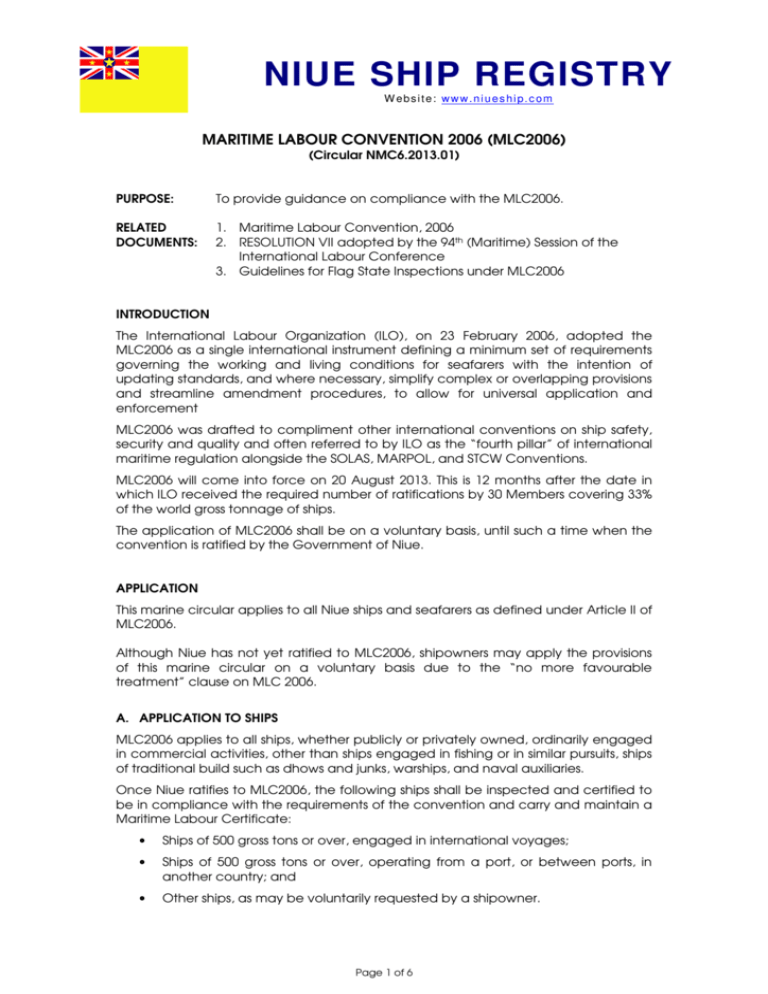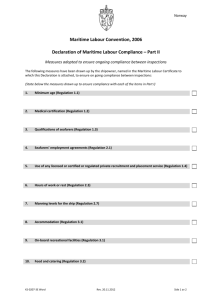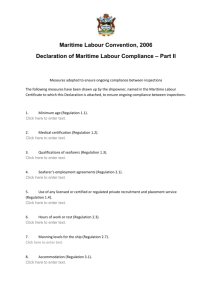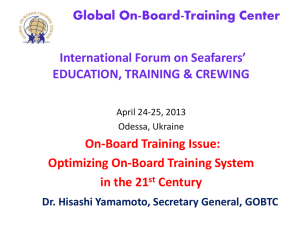niue ship registry
advertisement

NIUE SHIP REGISTRY W ebsite: www.niueship.com MARITIME LABOUR CONVENTION 2006 (MLC2006) (Circular NMC6.2013.01) PURPOSE: To provide guidance on compliance with the MLC2006. RELATED DOCUMENTS: 1. Maritime Labour Convention, 2006 2. RESOLUTION VII adopted by the 94th (Maritime) Session of the International Labour Conference 3. Guidelines for Flag State Inspections under MLC2006 INTRODUCTION The International Labour Organization (ILO), on 23 February 2006, adopted the MLC2006 as a single international instrument defining a minimum set of requirements governing the working and living conditions for seafarers with the intention of updating standards, and where necessary, simplify complex or overlapping provisions and streamline amendment procedures, to allow for universal application and enforcement MLC2006 was drafted to compliment other international conventions on ship safety, security and quality and often referred to by ILO as the “fourth pillar” of international maritime regulation alongside the SOLAS, MARPOL, and STCW Conventions. MLC2006 will come into force on 20 August 2013. This is 12 months after the date in which ILO received the required number of ratifications by 30 Members covering 33% of the world gross tonnage of ships. The application of MLC2006 shall be on a voluntary basis, until such a time when the convention is ratified by the Government of Niue. APPLICATION This marine circular applies to all Niue ships and seafarers as defined under Article II of MLC2006. Although Niue has not yet ratified to MLC2006, shipowners may apply the provisions of this marine circular on a voluntary basis due to the “no more favourable treatment” clause on MLC 2006. A. APPLICATION TO SHIPS MLC2006 applies to all ships, whether publicly or privately owned, ordinarily engaged in commercial activities, other than ships engaged in fishing or in similar pursuits, ships of traditional build such as dhows and junks, warships, and naval auxiliaries. Once Niue ratifies to MLC2006, the following ships shall be inspected and certified to be in compliance with the requirements of the convention and carry and maintain a Maritime Labour Certificate: • Ships of 500 gross tons or over, engaged in international voyages; • Ships of 500 gross tons or over, operating from a port, or between ports, in another country; and • Other ships, as may be voluntarily requested by a shipowner. Page 1 of 6 Mobile offshore drilling units (MODUs) are not required to be certified as they are not normally engaged in navigation or international voyages. The Convention allows for flexibility in implementation by providing for national determinations, substantial equivalencies, and exemptions and variations under certain provisions. The requirements in the Code implementing Regulation 3.1, Accommodation and recreational facilities, apply only to ships constructed on or after the date when the Convention enters into force. A ship shall be deemed to have been constructed on the date when its keel is laid or when it is at a similar stage of construction. For ships constructed before that date, the requirements relating to ship construction and equipment that are set out in the Accommodation of Crews Convention (Revised), 1949 (No. 92), and the Accommodation of Crews (Supplementary Provisions) Convention, 1970 (No. 133), shall continue to apply to the extent that they were applicable, prior to that date. B. APPLICATION TO SEAFARERS 1. MLC2006 applies to all seafarers on board the ships to which the Convention applies unless expressly provided otherwise. 2. MLC2006 recognizes in Article II, paragraph 3, that there may be doubts whether a particular category or categories of persons who may perform work on board a ship covered by the Convention should be regarded as seafarers. Recognizing that there is need for clarification on this subject to help to provide uniformity in the application in the rights and obligations provided by the Convention, the 94th (Maritime) Session of the International Labour Conference adopted Resolution VII to assist administrations in resolving any difficulties that may arise. 3. This Administration will consider the following issues, as provided for in Resolution VII, in determining whether certain persons or category of persons are considered seafarers: 3.1. the duration of the stay on board of the persons concerned; 3.2. the frequency of periods of work spent on board; 3.3. the location of the person’s principal place of work; 3.4. the purpose of the person’s work on board; and 3.5. the protection that would normally be available to the persons concerned with regard to their labour and social conditions to ensure they are comparable to that provided for under the Convention. 4. This Administration, taking into account the criteria provided in Resolution VII, considers that the following persons will not generally be considered as seafarers for the purpose of MLC2006: 4.1. Professional Pilots; 4.2. Port Workers; 4.3. Guest entertainers; 4.4. Ship Inspectors/Surveyors; 4.5. Ship Superintendents; 4.6. Repair and maintenance technicians; and 4.7. Temporary riding crew such as Suez Canal crew. Page 2 of 6 C. INSPECTIONS 1. Vessels who wish to comply voluntarily shall be inspected in accordance with MLC2006 and will be issued with a “Document of Compliance to Maritime Labour Convention (DOCMLC)”. 2. All inspections are to be carried out in accordance with the ILO document, Guidelines for Flag State Inspections under the Maritime Labour Convention, 2006. 3. When an inspection is conducted or when measures are taken under the MLC2006, the Recognized Organization (RO), or other authorized inspector, shall make all reasonable efforts to avoid a ship being unreasonably detained or delayed. 4. Initial Inspections 4.1. Ships shall undergo an initial inspection and receive a valid DOCMLC or Interim DOCMLC. 4.2. To verify that the MLC2006 requirements are being complied with and that the ship owner’s measures have been correctly implemented and are being followed, an inspector shall obtain supporting objective evidence by: 4.2.1.inspecting the relevant areas of the ship; 4.2.2.examining further documentation such as passports or other official documents, medical certificates, training records, crew lists and payroll records, seafarer employment agreements, safe manning documents and work and rest schedules; and 4.2.3.interviewing, in private, a representative number of seafarers, taking account of the need to preserve confidentiality and of the seafarers’ work and rest schedules. 5. Intermediate Inspections Ships shall undergo an intermediate inspection to ensure continuing compliance with the MLC2006 requirements and shall be conducted between the second and third anniversary dates of the DOCMLC and, if satisfactory, shall be endorsed by the RO. (Anniversary date means the day and month of each year which corresponds to the date of expiry of the DOCMLC). The scope and depth of the intermediate inspection shall be equal to that of a Renewal Inspection for renewal of the DOCMLC. 6. Renewal Inspections 6.1. Prior to expiry of the DOCMLC, vessels will need to carry out a renewal inspection that encompasses inspections for all requirements (as per initial inspection) and be renewed as follows: 6.1.1.When the renewal inspection is completed within three (3) months before the expiry of the existing DOCMLC, the new DOCMLC shall be valid from the date of completion of the renewal inspection for a period not exceeding five (5) years from the date of expiry of the existing DOCMLC. 6.1.2.When the renewal inspection is completed more than three (3) months before the expiry date of the existing DOCMLC, the new DOCMLC shall be valid for a period not exceeding five (5) years starting from the date of completion of the renewal inspection. D. CERTIFICATION 1. The SOCMLC, issued by the relevant RO, verifies that the working and living conditions of seafarers onboard a ship meet the MLC2006 requirements. Page 3 of 6 2. A RO shall issue or renew a DOCMLC to a vessel after completion of a satisfactory inspection as detailed in the Declaration of Maritime Labour Compliance (DMLC) Part I. 3. The DOCMLC issued and endorsed by the RO must have the DMLC Part I and II attached to it together with any record of inspection. 4. The DMLC is made up of 2 parts: 4.1. DMLC Part I is the statement drawn up by the Niue Ship Registry that references or describes the national laws, regulations or provisions with respect to the 14 areas of the MLC2006 that are subject to inspection for certification. It also records any flexibility, substantial equivalencies or exemptions which may have been applied to the ship after consultation with the relevant seafarers’ organization and the shipowner. 4.2. DMLC Part II is the statement drawn up by the ship owner / operator identifying the measures adopted to ensure ongoing compliance as detailed in the DMLC Part I and has to be certified compliant by the relevant RO prior to issuance of the DOCMLC. It should include the following: 4.2.1.when ongoing compliance shall be verified; 4.2.2.persons responsible for verification; 4.2.3.records to be taken; 4.2.4.procedures to be followed when non-compliance is noted; and 4.2.5.to ensure ongoing compliance, the DMLC Part II also should include general international requirements concerning advances in technology and scientific findings concerning workplace design. 4.3. A complete DMLC must consist of Part I and Part II as described above and both Parts must be submitted to the RO so that they can be combined for issuance of the DOCMLC to which the DMLC must be attached. 4.4. Both DMLC Part I and Part II can be downloaded in electronic format at www.niueship.com under “Download Forms.” 5. An Interim DOCMLC may be issued: 5.1. to new ships on delivery; 5.2. when a ship changes flag; or 5.3. when a shipowner assumes responsibility for the operation of a ship which is new to that shipowner. 6. An Interim DOCMLC must be endorsed by a relevant RO and may only be issued following verification that: 6.1. the ship has been inspected, as far as reasonable and practicable, for items listed in DMLC Part I; 6.2. the shipowner has demonstrated to the RO that the ship has adequate procedures to comply with the MLC2006; 6.3. the master is familiar with the MLC2006 and the responsibilities for implementation; and 6.4. relevant information has been submitted to the RO to produce a DMLC. 7. A DMLC need not be issued for the period of validity of the Interim DOCMLC. 8. ROs shall develop templates for the DOCMLC and Interim DOCMLC which conform to the model prescribed by MLC2006. 9. A copy of these certificates must be posted in a conspicuous place on board the ship to be available to the seafarers onboard. Page 4 of 6 10. The DOCMLC and the DMLC must be in English-language or translated in Englishlanguage for vessels engaged on international voyages. 11. The DOCMLC shall have a validity period of five (5) years, and shall be subject to an intermediate inspection between the second and third years of validity. 12. The Interim DOCMLC shall have a validity period not exceeding six (6) months. An inspection in accordance with DMLC Part I shall be carried out before the expiry of the Interim DOCMLC in order to issue of the full term DOCMLC. No further Interim DOCMLC may be issued after this initial six (6) months. 13. A DOCMLC or Interim DOCMLC shall cease to be valid in any of the following cases: 13.1. the relevant inspections are not completed within the specified time periods; 13.2. the DOCMLC is not endorsed by the RO; 13.3. when a ship changes flag; 13.4. when a shipowner ceases to assume the responsibility for the operation of a ship; and 13.5. when substantial changes have been made to the structure or equipment covered in Title 3 of the MLC2006, “Accommodation, Recreational Facilities, Food and Catering.” 14. DOCMLCs issued from now shall be convertible to full Maritime Labour Certificates when MLC2006 is ratified by the Government of Niue. E. DEFICIENCIES 1. A RO, or other authorized inspector, shall require the rectification of deficiencies in seafarers’ working and living conditions that have been identified as the result of an inspection and shall carry out inspections in this regard at the request of a port State. 2. Where there are grounds to believe that deficiencies constitute a serious breach of the MLC2006 or represent a significant danger to seafarers’ safety, health or security, an inspector shall, with the authorization of this Administration, prohibit a ship from leaving port until necessary corrective actions are taken. 3. A DOCMLC or Interim DOCMLC shall be withdrawn by the RO or the Administration if there is evidence that a ship does not comply with the requirements of MLC2006 and that the required corrective action has not been taken. When considering the withdrawal of a DOCMLC, the seriousness and frequency of the deficiencies shall be considered. 4. Where there is no clear breach of the requirements that endangers the safety, health or security of the seafarers and where there is no prior history of similar breaches, an RO shall have the discretion to give advice instead of instituting or recommending withdrawal of the DOCMLC. 5. If this Administration receives a complaint or sufficient evidence that a Niue flagged ship does not conform to the requirements of MLC2006, or identifies that there are serious deficiencies in the implementation of measures set out in the DMLC, then this Administration shall undertake to investigate the matter and ensure that action is taken to remedy the deficiencies identified. F. RECORD KEEPING 1. A DOCMLC shall have its records maintained and made publicly available by ROs. Page 5 of 6 2. Inspection reports in English shall be submitted to this Administration by ROs, and, if necessary, a copy to the master of the ship in the working language onboard which a copy shall be posted on the ship’s notice board. 3. Inspection records shall be kept by the master who shall record any significant deficiencies found during the inspection and their date of remedy. This record, if not in English, shall be accompanied by an English-language translation and appended to the DMLC so that it is available to seafarers, Flag State inspectors, authorized officers in port States and shipowners’ and seafarers’ representatives. 4. An investigation report shall be submitted by the RO, or other authorized inspector, to this Administration as soon as practicable in the event of an investigation concerning a major incident, but in any case not later than one month following the conclusion of the investigation. 5. If there is a change of flag, the RO shall, upon notification to this Administration, transmit to the competent authority of the gaining flag State existing copies of the DOCMLC and DMLC carried by the ship and, if applicable, copies of the relevant inspection reports if the competent authority of the gaining flag State requests them within three (3) months after the change of flag has taken place. G. SEAFARER COMPLAINTS 1. Ship owners / operators shall provide for on-board procedures for the fair, effective and expeditious handling of seafarer complaints alleging breaches of the requirements of the MLC2006, including seafarers’ rights. 2. Reference shall be made to circular NMC7.2013.01 H. CONFIDENTIALITY 1. RO inspectors, or other authorized inspectors, shall treat the source of any grievance or complaint alleging a danger or deficiency in relation to seafarers’ working and living conditions or a violation of laws and regulations as confidential, and give no intimation to the shipowner, the ship owner’s representative or the operator of the ship that an inspection was made as a consequence of such a grievance or complaint. Please do not hesitate to contact the Registry at technical@niueship.com or call: +65 6226-2001 for further assistance. Page 6 of 6




